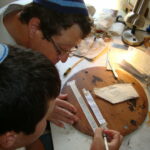Tefillin
“A youngster who knows how…to care for Tefillin his father [should] give him Tefillin.” Traditionally this was the practice, however, Tefillin has a special rule that a child must not only understand the importance of the mitzvah of Tefillin but he must keep himself very clean and can not pass gas while he is wearing them. Therefore educating a child to wear Tefillin is at an older age than education of other mitzvot, some have even done away with educating a youngster and prevent them from wearing Tefillin until the day of their Bar-Mitzvah.
The above source is cited by Rabbi Yosef Karo in the Shulchan Aruch and explains that care for Tefillin means that he should not sleep while wearing them and will not pass gas The Ramah adds from the Itur that a “youngster” here is one who is 13 years and one day. He adds that such is the custom and none should differ. The Mishna Brurah adds that before this time he certainly can not properly watch his Tefillin.
Rivkindcommented on this trend with regards to the singular opinion of Itur and the decision of the Mishna Brurah that the Magen Avraham said that still many are accustomed to teach a child to wear Tefillin several months early. Rivkind further says that people who are pious follow the custom to don Tefillin on the day that a child is Bar-Mitzva. This obviously only applies to Ashkenazim, the Sephardic customs will be discussed.
According to Rivkind Moroccans celebrate Bar-Mitzvahs at twelve years old. He goes on to say that this is indeed a kosher custom a cites several interesting sources. I have personally never seen or heard about such a custom and those Moroccans I have asked said that they never heard of such a thing.
In Jerusalem the custom is that from when a child is ten his father teaches him about Tefillin, if he can properly take care of them Others are accustomed to teach a child to wear Tefillin several months before he turns thirteen. On this day the feast would be made like the feast of wedding. Keter Shem Tob adds that if the family is wealthy they make an additional feast when the lad is exactly thirteen. I personally grew up knowing nothing other than this custom: that Tefillin are donned several months before and all of the feasts are done then. This was traditionally called “Yom HaTefillin” – The day of Tefillin, while the actual thirteenth birthday was called “Yom Hashlamat Haminyan” – the day of completing a quorum.
I have seen only one family of old Jerusalemites which purchased Tefillin for a child of ten. They purchased a simple pair of Tefillin with the intention of buying a nice pair for the Bar-Mitzva. They did not make a great feast.
Continue reading “History of the Bar-Mitzvah – Tefillin, Aliyah, Mitzvot”









